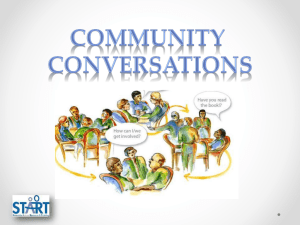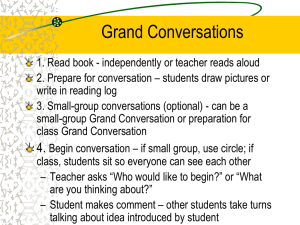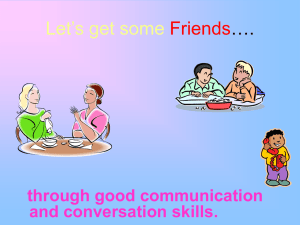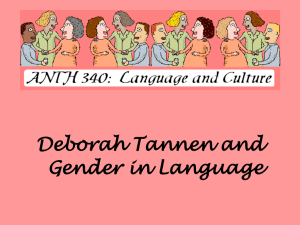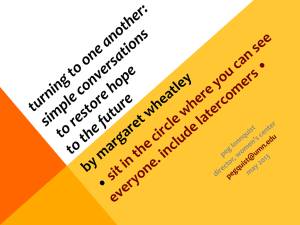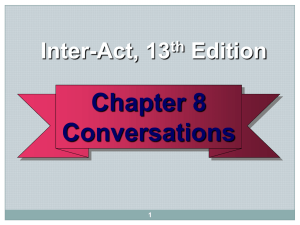Communication Accommodation Theory
advertisement
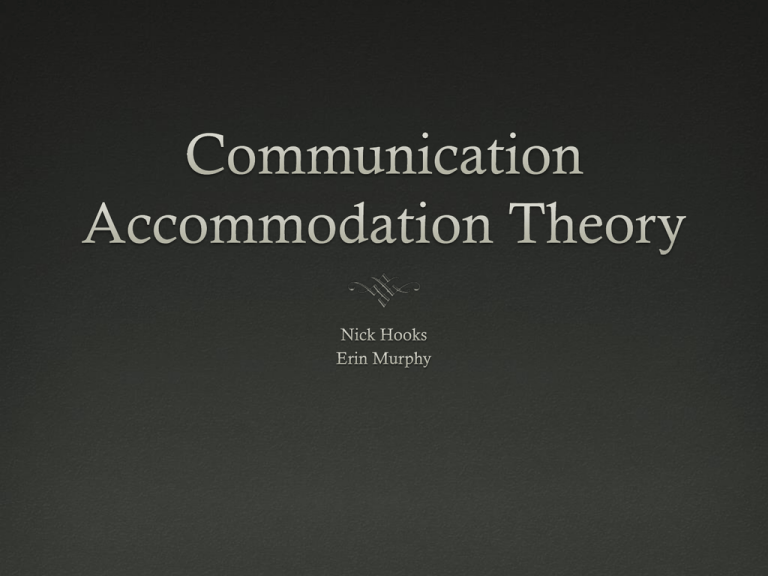
Luke Tomsha and Roberto Hernandez Assumption #1 Speech behavioral similarities and dissimilarities exist in all conversations Past experiences form a person’s field of experience, and those fields of experience are brought into conversations. These varied experiences determine the extent to which one person will accommodate another. The more similar our attitudes and beliefs, the more attracted to and accommodating we will be to the other person in the conversation. Assumption #2 The manner in which we perceive the speech and behaviors of another will determine how we evaluate a conversation This assumption is based around the concepts of perception and evaluation. Perception is the process of attending to and interpreting a message, whereas evaluation is the process of judging the conversation. In addition, motivation is an important factor in the perception and evaluation processes, in that while we may perceive another person’s speech and behaviors, but we may not always evaluate them. Assumption #3 Language and behaviors impart information about social status and group belonging This pertains to the effects that language has on others. Language has the ability to communicate status and group belonging between communicators in a conversation, and the language in a conversation will often reflect the individual with the higher social status. The person of the lower social status in any conversation will often accommodate the person of the higher social class, due to their desire to become apart of the other person’s group or social class. Assumption #4 Accommodation varies in its degree of appropriateness, and norms guide the accommodation process. This assumption focuses on norms and issues of social appropriateness. Norms are the expectations of behavior in conversation. Accommodation in a conversation is not always worthwhile and beneficial, and can at times even be inappropriate. Convergence Convergence is “a strategy whereby individuals adapt to each other’s communicative behaviors” People may adapt to speech rate, pause, smiling, eye gaze, and other verbal and nonverbal behaviors. This is a process we don’t always choose to utilize. When we do choose to converge, perceptions of the other person’s speech or behaviors are relied on. Convergence is largely based on attraction, the greater the attraction between communicators, the more convergence happens. Attraction encompasses things like liking, charisma, and credibility. Also, the likelihood of future interactions, ability to communicate, and status differential. All of this is a process that occurs over time. Convergence usually depends on whether the convergence is thoughtful, and it can be perceived as good and bad in the communication process. Indirect stereotyping – imposing outdated and rigid assumptions of a cultural group upon that group. Divergence Divergence is a strategy used to accentuate the verbal and nonverbal differences between communicators, or in other words, a nonaccommodation. Different from convergence in that there are no attempts to display similarities in gestures, posture, speech rate, etc. between speakers. There isn’t an effort made to “reduce social distance or to make communication smoother”. It is not an effort to disagree with one-another, it is more that two people have made a choice to dissociate themselves from the person and the topic. It can serve as a way to maintain a social identity and can be used deliberately to have “identity, cultural pride, and distinctiveness”. Divergence occurs often when there is a difference in power between communicators. This can be seen in conversations between parent and child, physician and patient, interviewer and interviewee, etc. Giles contend that divergence is used to contrast self-images in a conversation. The divergence is carried out by the individual who wants to imply a status difference between the two communicators. Overaccommodation: Overaccommodation is an attempt to overdo efforts in regulating, modifying, or responding to others. It has the effect of making the target feel worse, existing in three forms: sensory overaccommodation, dependence overaccommodation, and intergroup overaccommodation. Sensory overaccommodation: when a speaker adapts too much to the other who is seen as limited. This limitation is typically a linguistic or a physical one. The speaker may believe that they are sensitive to the others disability, but is over the top with the accommodation. This can be described as an underestimation of the other communicator. Dependency overaccommodation: occurs when speakers place listeners in a lower-status role. The listener is seen as dependent on the speaker, believing that they control the conversation to show their higher status. Example: Immigrants in a new country made to feel subordinate when speaking with others. Intergroup overaccommodation: occurs when speakers place listeners in cultural groups without acknowledging individual uniqueness. This usually results in listeners perceiving that they are less than equal leading to loss of motivation, avoidance, and forming negative attitudes towards society. Scope of CAT While the theory originally was created purely to examine speech; it was later expanded to include the nonverbal arena. While some claim that this undermines the theory’s integrity, the changing nature of Western society suggests that this theory may need to be extensive in order to understand multiple populations. Criticisms of CAT Although there has been little scholarly critisism, there are still a number of concerns pertaining to the testability of the concepts in Communication Accomodation theory. Many scholars, for example, question the convergence-divergence frame, and claim that conversations are too complex to be reduced simply to these processes. They question what happens if people both converge and diverge in a conversation, and question the roles of race or ethnicity in the process. Other scholars question whether the theory relies too heavily on rational forms of communicating. Although the theory acknowledges conflict between communicators, it ingores the possibility that one person in the conversation may be overly hostile or lack any sense of reason.

